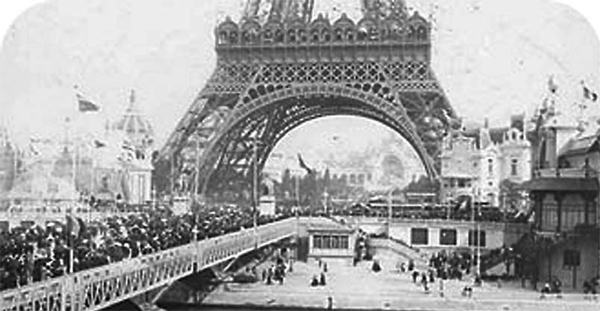

|
 |
| View at the base of the Eiffel Tower, 1889 Paris Expo. |
From the first Expo in London in 1851, which showcased Great Britain's industrial dominance, to the most recent, in Aichi, Japan, 2005, which highlighted environmental awareness, the content, concept and circumstance of the Expo evolved dramatically over the last 159 years.
1851
Location: London, UK
Duration: 140 days
Visitors: 6 million
| |||
The famed Crystal Palace was designed to house the show. Constructed from iron and glass, the building was not only an architectural marvel but also an engineering triumph. It was destroyed by fire in 1936.
Exhibits - 13,000 in total - came from throughout Britain and its far-flung empire. They included a Jacquard loom, an envelope machine, kitchen appliances, and steel-making displays.
Six million people, a third of the population of Britain at the time, visited the exhibition.
1876
Location:Philadelphia, US
Duration: 159 days
Visitors: 10 million
The first official World Expo in the United States was held to celebrate the 100th anniversary of the signing of the Declaration of Independence.
Star exhibits included the Corliss Steam Engine, the first automatic screw-making machinery, Alexander Graham Bell's telephone, the Remington Typographic Machine (typewriter), and Heinz Ketchup.
1889
Location: Paris, France
Duration: 182 days
Visitors: 28 million
The Expo was held during the 100th anniversary of the storming of the Bastille, an event considered the beginning of the French Revolution.
The main exhibit at the Expo was the Eiffel Tower, which served as the entrance arch to the event. The 300-meter iron tower, designed by Gustave Eiffel, was the world's tallest manmade structure until it was surpassed by New York's Empire State Building in 1931.
The Expo attracted many luminaries, including the Prince of Wales; artists Paul Gauguin and Vincent van Gogh; and inventor Thomas Edison, whose electric lamps illuminated the Expo.
1900
Location: Paris, France
Duration: 210 days
Visitors: 50 million
This Expo was also held in Paris. The event was to celebrate the achievements of the past century and to accelerate development into the next.
The Expo was where the marvels of film were introduced to the world. Brief films depicting opera and ballet were shown to the public. The diesel engine and escalators were also introduced.
The Expo also featured the second Olympic Games, which was spread over five months. The games marked the first participation by female athletes and the first international team events. Intriguing exhibits and the long duration of the event accounted for the huge number of visitors.
1933
Location: Chicago, US
Duration: 170 days
Visitors: 22 million
"A Century of Progress" was the theme of the Expo, held to celebrate the city's centennial.
One of the highlights was the arrival of the 236.5-meter German airship, Graf Zeppelin. For some, the airship was not welcome, as it had become a symbol of the ascendancy to power of Adolf Hitler earlier that year.
The introduction of Cadillac's V-16 limousine, Nash's vertical parking garage, Lincoln's "concept car" precursor to the Lincoln-Zephyr, and Pierce-Arrow's modernistic Silver Arrow, symbolized the flourishing US auto industry.
1958
Location: Brussels, Belgium
Duration: 186 days
Visitors: 42 million
The Expo was held from April 17 to Oct 19 and was the first major World Expo since World War II.
Many of the buildings were re-used from the Brussels International Exposition in 1935, which had been held on the same site. Belgium's King Baudouin opened the Expo with a call for world peace, and social and economic progress.
The site is best known for a giant model of the Atomium, and it remains a Brussels' landmark.
1970
Location: Osaka, Japan
Duration: 182 days
Visitors: 64 million
Like the 1964 Summer Olympics, Expo 1970 was a success and served as a symbol of the rapid development of Japan in the 1960s. The Expo was themed: "Progress and Harmony for Mankind."
Seventy-seven countries were represented at the event and it remains one of the largest and best-attended Expos in history.
1992
Location: Seville, Spain
Duration: 176 days
Visitors: 41 million
The Universal Exposition of Seville (Expo 1992) took place from April 20 to Oct 12. The theme was: "The Age of Discovery". Over 100 countries were represented.
Expo 1992 celebrated the 500th anniversary of the discovery of the Americas by Christopher Columbus.
The Seville Expo was known for the large area of the site, its numerous spectacular gates and bridges and for the diversity of transport - buses, ferries, cable cars and a monorail.
2000
Location: Hanover
Duration: 153 days
Visitors: 25 million
The first Expo of the 21st century was held from June 1 to Oct 31.
Just over half of the expected 40 million visitors showed up, resulting in $600 million in loses.
Part of the failure of the Expo was a lack of perception of what to expect, with companies unsure of where their money was going.
2005
Location: Aichi, Japan
Duration: 185 days
Visitors: 22 million
The theme of the Aichi Expo was: "Nature's Wisdom". National and corporate pavilions expressed themes of ecological coexistence, renewable technology and the wonders of nature.
Great care was taken to build the pavilions out of recycled or recyclable materials to minimize environmental impact on the site, and to provide environmentally friendly transportation to and within the Expo area.
China Daily
(China Daily 05/01/2010 page36)
